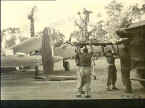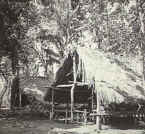 |
| Category:
Air
support/WW2/Allied |

|
|
|
|
|
|
1 Air Ambulance Unit
RAAF (1 AAU) |
|
A
total of 8,252 patients were airlifted by 1 AAU during the unit's
service in the Middle East and Italy. |
 |
Libya.
1941-12. The crew of an aircraft of the No.
1 Air Ambulance Unit (1AAU), RAAF,
checking aerodrome locations on the map before taking off. |
 |
Libya.
1941-11. A blazing Air Ambulance
of No. 3 Squadron, RAAF, which was
shot down by German air gunners. The crew of three escaped although one
was badly burned. No patients were on board at the time. |
 |
1943-02-26.
Middle East. A De Havilland DH 86A
Air Ambulance (A31-7), one of
eight used by the RAAF from 1939 until 1945. Capable of carrying one
doctor and up to eight patients, (six of whom can be carried on
stretchers), these four engined biplanes served with 35 and 36 Squadrons
and 1 Air Ambulance Unit (1 AAU). A31-7 served with 1 AAU in the Middle
East. It arrived at Cairo on 3 July 1941 and was based at Gaza and
Gerawla supporting the work of 1 Australian General Hospital before
being damaged on the ground in an enemy attack on Mersa Matruh airfield
on 31 January 1942. Despite being riddled with shrapnel holes, it was
repaired with parts scavenged from enemy aircraft and flown again, being
the only aircraft 1 AAU had which was capable of flying for most of the
first half of 1942. As the last operational DH 86A, A31-7 was withdrawn
from use due to the unavailability of 77-octane fuel after transporting
patients during the Italian campaign in 1943. It has been suggested that
the aircraft was then dismantled for spares and probably scrapped. |
 |
Torokina,
Bougainville Island, Solomon
islands. C. 1945-02-18. Army patient being lifted from ambulance prior
to being loaded on an air ambulance aircraft of No. 37 (Transport)
Squadron RAAF at Piva airfield for evacuation to a base hospital. |
 |
Interior
of air ambulance aircraft, showing
6-litter configuration, cleated floor (for traction with aircraft on
ground), backward facing seat for ambulant patient or attendant on left
and thermos flasks for hot food at rear. Photograph published in Australia
in the War of 1939-45, medical, Vol 4, medical services of the RAN and RAAF,
page 271. |
 |
Nadzab,
New Guinea. 1943-11. Wards of the
strip A.D.S (advanced dressing station) set up and staffed by the 10th
Field Ambulance for the holding and treatment of patients awaiting air
evacuation.
|
|
